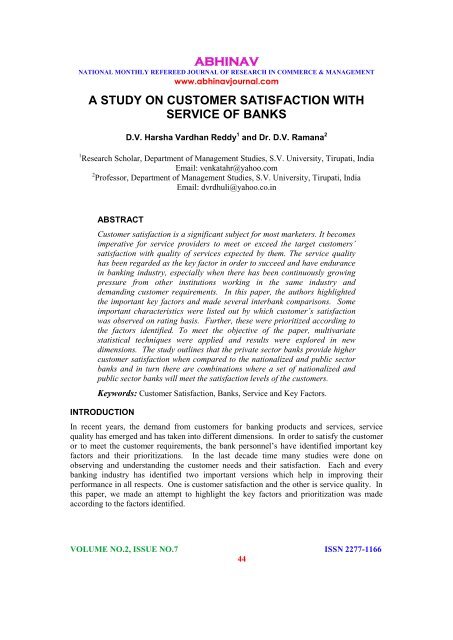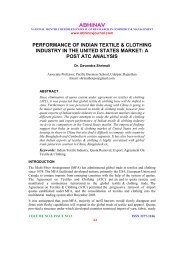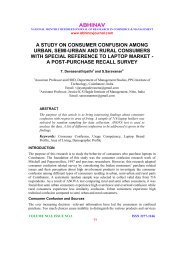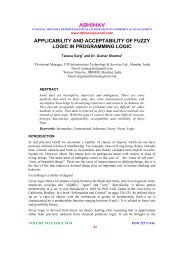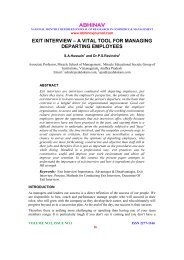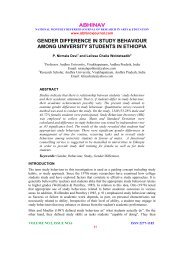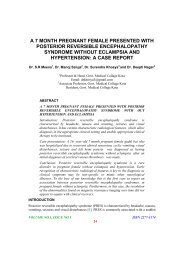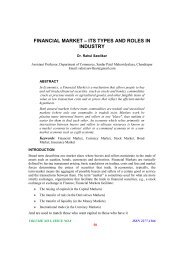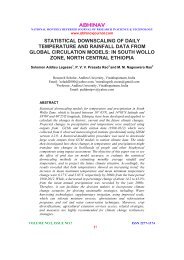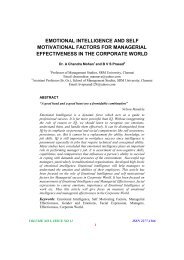Abhinav Institute of Management & Research
Abhinav Institute of Management & Research
Abhinav Institute of Management & Research
Create successful ePaper yourself
Turn your PDF publications into a flip-book with our unique Google optimized e-Paper software.
ABHINAV<br />
NATIONAL MONTHLY REFEREED JOURNAL OF RESEARCH IN COMMERCE & MANAGEMENT<br />
www.abhinavjournal.com<br />
A STUDY ON CUSTOMER SATISFACTION WITH<br />
SERVICE OF BANKS<br />
D.V. Harsha Vardhan Reddy 1 and Dr. D.V. Ramana 2<br />
1 <strong>Research</strong> Scholar, Department <strong>of</strong> <strong>Management</strong> Studies, S.V. University, Tirupati, India<br />
Email: venkatahr@yahoo.com<br />
2 Pr<strong>of</strong>essor, Department <strong>of</strong> <strong>Management</strong> Studies, S.V. University, Tirupati, India<br />
Email: dvrdhuli@yahoo.co.in<br />
ABSTRACT<br />
Customer satisfaction is a significant subject for most marketers. It becomes<br />
imperative for service providers to meet or exceed the target customers’<br />
satisfaction with quality <strong>of</strong> services expected by them. The service quality<br />
has been regarded as the key factor in order to succeed and have endurance<br />
in banking industry, especially when there has been continuously growing<br />
pressure from other institutions working in the same industry and<br />
demanding customer requirements. In this paper, the authors highlighted<br />
the important key factors and made several interbank comparisons. Some<br />
important characteristics were listed out by which customer’s satisfaction<br />
was observed on rating basis. Further, these were prioritized according to<br />
the factors identified. To meet the objective <strong>of</strong> the paper, multivariate<br />
statistical techniques were applied and results were explored in new<br />
dimensions. The study outlines that the private sector banks provide higher<br />
customer satisfaction when compared to the nationalized and public sector<br />
banks and in turn there are combinations where a set <strong>of</strong> nationalized and<br />
public sector banks will meet the satisfaction levels <strong>of</strong> the customers.<br />
Keywords: Customer Satisfaction, Banks, Service and Key Factors.<br />
INTRODUCTION<br />
In recent years, the demand from customers for banking products and services, service<br />
quality has emerged and has taken into different dimensions. In order to satisfy the customer<br />
or to meet the customer requirements, the bank personnel‟s have identified important key<br />
factors and their prioritizations. In the last decade time many studies were done on<br />
observing and understanding the customer needs and their satisfaction. Each and every<br />
banking industry has identified two important versions which help in improving their<br />
performance in all respects. One is customer satisfaction and the other is service quality. In<br />
this paper, we made an attempt to highlight the key factors and prioritization was made<br />
according to the factors identified.<br />
VOLUME NO.2, ISSUE NO.7 ISSN 2277-1166<br />
44
ABHINAV<br />
NATIONAL MONTHLY REFEREED JOURNAL OF RESEARCH IN COMMERCE & MANAGEMENT<br />
www.abhinavjournal.com<br />
REVIEW OF LITERATURE<br />
Customer satisfaction plays a vital role in gearing up the banking sectors and their<br />
performance. Here we have made a short review about the studies relating to the customer<br />
satisfaction and the service quality. Vigg Silky et. Al (2007) stated some <strong>of</strong> the factors<br />
responsible for customer satisfaction. The factors that influence the customer satisfaction are<br />
Innovative Services, Network, Access, Technicalities, Behavior, Comfort and Image. Their<br />
study revealed that public and private sector banks do not differ significantly in providing<br />
customer satisfaction. Hummayoun et. Al (2009) carried out comparative investigations to<br />
identify the impact <strong>of</strong> service quality on customer satisfaction in banking sector. Their study<br />
resulted that service quality is the strong predictor <strong>of</strong> customer satisfaction. They have stated<br />
that if any particular bank effectively manages the service quality that bank can satisfy the<br />
customers. Uma Sankar et. Al (2010), conducted a study on identifying the major reasons for<br />
dissatisfaction with public sector banks. Ushad Subadar Agathee (2010) advocated that there<br />
are increasing urgent needs for bankers to meet customer expectations for faster and better<br />
service with the number <strong>of</strong> branches. Their study revealed that the high income group<br />
customers are more likely to be dissatisfied with banks services and it is highlighted in the<br />
study that to improve the customer service and quality improvement, the bankers has to gear<br />
upon two components i.e., reliability and responsiveness.<br />
Kajal Chaudhary and Monika Sharma (2011), made an attempt to analyze how efficiently the<br />
public and private sector banks have been managing NPA. Their study recommended that<br />
the bank staff should be trained about the proper documentation in NPA. Surabhhi Singh and<br />
Renu Arora (2011), suggested that training on stress management and public dealing should<br />
be imparted to the employees <strong>of</strong> nationalized banks. Their results indicate that the customers<br />
<strong>of</strong> nationalized banks were not satisfied with the employee behavior, ambience and<br />
infrastructure, while respondents <strong>of</strong> private and foreign banks were not satisfied with high<br />
charges, accessibility and communication. Kailash, M (2012) compared performance among<br />
two categories <strong>of</strong> banks such as public and private sectors.<br />
Roth Aleda V et. al (1991), said that the competitive priorities <strong>of</strong> retail banks was<br />
empirically linked with operations strategy contents <strong>of</strong> structure, infrastructure and<br />
integration choices. Zaithaml et. al (1996) <strong>of</strong>fered a conceptual model <strong>of</strong> the impact <strong>of</strong><br />
service quality on particular behavior that signal whether customers remain with or defect<br />
from a company. Using the proposed model, they have examined the relationships<br />
concerning customers‟ behavioral intentions which have strongly influenced service quality.<br />
Abratt and Russell (1999), have suggested the key factors influencing customers‟ selection<br />
<strong>of</strong> a bank that includes the range <strong>of</strong> services, rates, fees and prices charged. There have been<br />
several studies emphasizing the significance <strong>of</strong> customer retention in banking industry<br />
(Dawkins and Reichheld, 1990; Zimmerman, 1999; Page, Pitt and Berthon, 1996; Reichheld<br />
and Kenny, 1990; Fisher, 2001). Fornell (1992) noted that although customer satisfaction<br />
and quality appear to be important for all firms, satisfaction is more important for loyalty in<br />
industries such as banks, insurance mail order and automobiles. Armistead, Pritchard and<br />
Machin (1999) suggested and predicted two critical challenges which prevail on customer<br />
satisfaction. Several studies (Schleringer and Heskett, 1991; Norman and Ramirez, 1993;<br />
Liedtka et al, 1997) focused on the specific relationship between employee satisfaction,<br />
service quality and customer satisfaction. In these studies, the relationship is <strong>of</strong>ten described<br />
VOLUME NO.2, ISSUE NO.7 ISSN 2277-1166<br />
45
ABHINAV<br />
NATIONAL MONTHLY REFEREED JOURNAL OF RESEARCH IN COMMERCE & MANAGEMENT<br />
www.abhinavjournal.com<br />
as the „ Satisfaction Mirror‟ reinforcing the idea that business success results from employee<br />
satisfaction being „reflected‟ in terms <strong>of</strong> customer satisfaction.<br />
Whilst Silvestro and Cross (2000) cast some doubts on the strength <strong>of</strong> the relationship, the<br />
balance <strong>of</strong> evidence suggests that employee satisfaction is a key driver <strong>of</strong> service quality and<br />
customer satisfaction. Voss et. al (2004) found that employee satisfaction directly affects<br />
both service quality and customer satisfaction. Vilares and Coehlo (2003) have convinced<br />
about the recommended changes to the existing customer satisfaction indexes (ECSI) which<br />
recognized that there exists a „cause and effect‟ relationship between employee behavior and<br />
customer satisfaction. Kano et. al (1984) identified three types <strong>of</strong> customer requirements;<br />
they are “must be”, “ one dimensional” and “attractive”. “Must be” requirements are simply<br />
taken for granted by the customer. “One dimensional” requirements, customer satisfaction is<br />
proportional to the level <strong>of</strong> fulfillment. “Attractive” requirements provide the greatest<br />
opportunity to „delight‟ the customer. Lewis (1995) adopted the terminology <strong>of</strong> „hygiene<br />
factors‟, „enhancing factors‟ and „dual threshold factors‟.<br />
OBJECTIVES<br />
1. To assess the performance <strong>of</strong> the banks based on customer satisfaction, service<br />
quality, and other related factors<br />
2. To identify the key factors which influence the performance other than customer<br />
satisfaction and service quality<br />
METHODOLOGY<br />
The information from the meta- analysis about the customer satisfaction, service quality and<br />
other related factors, the performance <strong>of</strong> the banks will be assessed. Considering this as a<br />
key point, we have focused on key factors which influence the performance other than the<br />
satisfaction and service quality. The study was carried out by collecting responses from<br />
respondents (N = 838). The questionnaire includes few demographic variables and some<br />
questions which focus on the customer satisfaction and quality provided by the bank<br />
industries on a likert scale. A brief pr<strong>of</strong>ile <strong>of</strong> the respondents is reported in table 1. Using<br />
the visual binning technique in PASW SPSS 18.0, we have categorized the variable age into<br />
five groups and it shows that majority <strong>of</strong> the respondents were observed to be in the age<br />
group <strong>of</strong> 25-35 (65.04%) and then in the age group <strong>of</strong> 35-45 (18.50%). In a similar way, the<br />
data characteristics are reported for the remaining variables like, occupation, education,<br />
gender and monthly income.<br />
Table 1. Pr<strong>of</strong>ile <strong>of</strong> Respondents<br />
N = 838<br />
Variable Categories Frequency Percentages<br />
Age (Years) < 25 5 0.60<br />
25 – 35 545 65.04<br />
35 – 45 155 18.50<br />
45 – 55 110 13.13<br />
> 55 23 2.74<br />
VOLUME NO.2, ISSUE NO.7 ISSN 2277-1166<br />
46
ABHINAV<br />
NATIONAL MONTHLY REFEREED JOURNAL OF RESEARCH IN COMMERCE & MANAGEMENT<br />
www.abhinavjournal.com<br />
Table 1. Pr<strong>of</strong>ile <strong>of</strong> Respondents (Contd….)<br />
N = 838<br />
Variable Categories Frequency Percentages<br />
Occupation None 45 5.37<br />
Business 84 10.02<br />
Employee 308 36.75<br />
Others 401 47.85<br />
Education None 51 6.09<br />
Under graduation 94 11.22<br />
Graduation 397 47.37<br />
Post graduation 296 35.32<br />
Gender Male 485 57.88<br />
Female 353 42.12<br />
Monthly gross income (Rs.) None 81 9.67<br />
< 15,000 367 43.79<br />
15,001 - 30,000 274 32.70<br />
30,001 - 45,000 75 8.95<br />
> 45,000 41 4.89<br />
Univariate and Multivariate Statistical Techniques such as One way Analysis <strong>of</strong> Variance,<br />
Factor Analysis were also applied to the data to know the satisfaction levels <strong>of</strong> the customers<br />
as well as these techniques help to observe and identify the performance <strong>of</strong> public, private<br />
sector banks respectively. For the questions on Likert scale, the Factor analysis was applied<br />
to identify the factors and its components. Further, the same technique has been run for the<br />
services provided by the banks using Principal component analysis as an extraction method<br />
considering Varimax rotation. In table 2, the mean responses for each feature were reported<br />
along with respective standard deviation. Ranks were given to each and every feature based<br />
on their highest and lowest mean ratings.<br />
Table 2. Standard Deviation <strong>of</strong> Features to attain customer satisfaction<br />
Features (N = 838)<br />
Mean Std. Deviation Rank<br />
Attitude <strong>of</strong> the bank employee to serve the customers 4.07 0.881 1<br />
Care and concern for the customers 3.95 0.986 2<br />
Services are as per my requirements 3.79 1.039 3<br />
Physical facilities 3.79 0.968 4<br />
Promptness in attending to customer needs 3.72 1.01 5<br />
Fairness in service charges 3.7 1.044 6<br />
Use <strong>of</strong> technology in banks 3.69 0.873 7<br />
Availability <strong>of</strong> information 3.68 1.012 8<br />
Courteous behavior <strong>of</strong> staff 3.67 1.036 9<br />
Responsiveness to complaints 3.66 1.055 10<br />
Advice to customers 3.66 1.094 11<br />
VOLUME NO.2, ISSUE NO.7 ISSN 2277-1166<br />
47
ABHINAV<br />
NATIONAL MONTHLY REFEREED JOURNAL OF RESEARCH IN COMMERCE & MANAGEMENT<br />
www.abhinavjournal.com<br />
Table 2. Standard Deviation <strong>of</strong> Features to attain customer satisfaction (Contd….)<br />
Features (N = 838)<br />
Mean Std. Deviation Rank<br />
Variety <strong>of</strong> services 3.62 1.028 12<br />
Appearance, cleanliness and hygiene 3.59 1.012 13<br />
Interest rates on loans 3.58 0.962 14<br />
Interest rates on deposits 3.58 0.979 15<br />
Speed <strong>of</strong> transactions 3.58 1.025 16<br />
Introduction <strong>of</strong> new service 3.55 1.018 17<br />
Knowledge level <strong>of</strong> staff 3.51 1.052 18<br />
Communication <strong>of</strong> staff 3.47 1.04 19<br />
Efficiency <strong>of</strong> staff 3.44 1.062 20<br />
KMO and Bartlett's Test a<br />
Kaiser-Meyer-Olkin Measure <strong>of</strong> Sampling Adequacy. .879<br />
Bartlett's Test <strong>of</strong> Sphericity Approx. Chi-Square 2612.285<br />
Df 190<br />
Sig. .000<br />
Table 3. Total Variance table<br />
Total Variance Explained<br />
Initial Eigen values<br />
Extraction Sums <strong>of</strong> Squared Rotation Sum <strong>of</strong> Square<br />
Loadings<br />
Loadings<br />
% <strong>of</strong> Cumulative % <strong>of</strong> Cumulative Total % <strong>of</strong> Cumulative<br />
Total<br />
Total<br />
Variance %<br />
Variance % Variance %<br />
4.54822.740 22.740 4.548 22.740 22.740 2.322 11.609 11.609<br />
1.4327.158 29.898 1.432 7.158 29.898 2.064 10.321 21.930<br />
1.2746.372 36.270 1.274 6.372 36.270 2.035 10.175 32.106<br />
1.0805.401 41.671 1.080 5.401 41.671 1.913 9.566 41.671<br />
.976 4.881 46.552<br />
.925 4.624 51.177<br />
.911 4.554 55.731<br />
.841 4.206 59.936<br />
.816 4.079 64.015<br />
.792 3.959 67.975<br />
.767 3.836 71.810<br />
.729 3.647 75.458<br />
.710 3.551 79.009<br />
.670 3.351 82.360<br />
.652 3.261 85.621<br />
.631 3.157 88.778<br />
VOLUME NO.2, ISSUE NO.7 ISSN 2277-1166<br />
48
ABHINAV<br />
NATIONAL MONTHLY REFEREED JOURNAL OF RESEARCH IN COMMERCE & MANAGEMENT<br />
www.abhinavjournal.com<br />
Total Variance Explained<br />
Initial Eigen values<br />
Extraction Sums <strong>of</strong> Squared Rotation Sum <strong>of</strong> Square<br />
Loadings<br />
Loadings<br />
% <strong>of</strong> Cumulative % <strong>of</strong> Cumulative Total % <strong>of</strong> Cumulative<br />
Total<br />
Total<br />
Variance %<br />
Variance % Variance %<br />
17 .606 3.028 91.806<br />
18 .593 2.966 94.772<br />
19 .563 2.814 97.586<br />
20 .483 2.414 100.000<br />
The above table titled Total Variance Explained summarizes the total variance explained by<br />
the Factor Analysis solution and gives an indication about the number <strong>of</strong> useful factors.<br />
Initial Eigen Values gives the variance explained by all possible factors. There are four main<br />
components and 41.67% is explained by all the four extracted factors.<br />
Table 4. Component Matrix Table<br />
Rotated Component Matrix a,b<br />
Features<br />
Component<br />
1 2 3 4<br />
Attitude <strong>of</strong> the bank employee to serve the customers 0.751 -0.011 0.022 -0.022<br />
Care and concern for the customers 0.687 0.140 0.076 0.119<br />
Services are as per my requirements 0.515 0.407 0.119 -0.078<br />
Physical facilities 0.130 0.400 0.089 0.492<br />
Promptness in attending to customer needs 0.274 0.343 0.171 0.328<br />
Fairness in service charges 0.119 0.614 0.003 0.061<br />
Use <strong>of</strong> technology in banks 0.010 0.184 0.010 0.708<br />
Availability <strong>of</strong> information 0.397 0.338 0.027 0.323<br />
Courteous behaviour <strong>of</strong> staff 0.516 -0.202 0.191 0.402<br />
Responsiveness to complaints 0.485 0.151 0.177 0.142<br />
Advice to customers 0.242 0.266 0.266 0.191<br />
Variety <strong>of</strong> services 0.350 0.441 0.140 0.019<br />
Appearance, cleanliness and hygiene 0.018 0.559 0.161 0.200<br />
Interest rates on loans -0.007 0.610 0.129 0.112<br />
Interest rates on deposits 0.173 0.057 0.231 0.343<br />
Speed <strong>of</strong> transactions 0.031 0.063 0.213 0.652<br />
Introduction <strong>of</strong> new service 0.163 0.022 0.552 0.232<br />
Knowledge level <strong>of</strong> staff 0.051 0.160 0.533 0.255<br />
Communication <strong>of</strong> staff 0.062 0.111 0.744 0.041<br />
Efficiency <strong>of</strong> staff 0.105 0.132 0.731 0.000<br />
From the above table we observe that, factor 1 comprises <strong>of</strong> Attitude <strong>of</strong> the bank employee<br />
to serve the customers, care and concern for the customers, services are as per my<br />
VOLUME NO.2, ISSUE NO.7 ISSN 2277-1166<br />
49
ABHINAV<br />
NATIONAL MONTHLY REFEREED JOURNAL OF RESEARCH IN COMMERCE & MANAGEMENT<br />
www.abhinavjournal.com<br />
requirements, availability <strong>of</strong> information, courteous behavior <strong>of</strong> staff and responsiveness to<br />
complaints. Factor 2 consists <strong>of</strong> promptness in attending customer needs, fairness in service<br />
charges, advice to customers, variety <strong>of</strong> services, Appearance, cleanliness and hygiene and<br />
interest rates on loans. Factor 3 consists <strong>of</strong> introduction <strong>of</strong> new service, knowledge level <strong>of</strong><br />
staff, communication <strong>of</strong> staff and efficiency <strong>of</strong> staff. Factor 4 comprises <strong>of</strong> physical facilities,<br />
use <strong>of</strong> technology in banks, interest rates on deposits and speed <strong>of</strong> transactions.<br />
Table 5. Ranks <strong>of</strong> the characteristics<br />
S.No Site Characteristics<br />
Mean S D<br />
Rank <strong>of</strong><br />
item<br />
Factor -1<br />
1 Attitude <strong>of</strong> the bank employee to serve the customers 4.07 0.881 1<br />
2 Care and concern for the customers 3.95 0.986 2<br />
3 Services are as per my requirements 3.79 1.039 3<br />
8 Availability <strong>of</strong> information 3.68 1.012 8<br />
9 Courteous behaviour <strong>of</strong> staff 3.67 1.036 9<br />
10 Responsiveness to complaints 3.66 1.055 10<br />
Factor -2<br />
5 Promptness in attending to customer needs 3.72 1.01 5<br />
6 Fairness in service charges 3.7 1.044 6<br />
11 Advice to customers 3.66 1.094 11<br />
12 Variety <strong>of</strong> services 3.62 1.028 12<br />
13 Appearance, cleanliness and hygiene 3.59 1.012 13<br />
14 Interest rates on loans 3.58 0.962 14<br />
Factor -3<br />
17 Introduction <strong>of</strong> new service 3.55 1.018 17<br />
18 Knowledge level <strong>of</strong> staff 3.51 1.052 18<br />
19 Communication <strong>of</strong> staff 3.47 1.04 19<br />
20 Efficiency <strong>of</strong> staff 3.44 1.062 20<br />
Factor -4<br />
4 Physical facilities 3.79 0.968 4<br />
7 Use <strong>of</strong> technology in banks 3.69 0.873 7<br />
15 Interest rates on deposits 3.58 0.979 15<br />
16 Speed <strong>of</strong> transactions 3.58 1.025 16<br />
Note: Scale: 5-point scale. 5-Great extent 1-Never<br />
DATA ANALYSIS AND INTERPRETATION<br />
The one way ANOVA test has been performed for the total score and the banks. The test<br />
statistic value is found to be 7.034 and there is a high significance between the banks. On<br />
performing Duncan‟s Multiple Range Test, we observe that the banks are categorized into 6<br />
groups depending on their mean values. There exists a significant difference between the<br />
VOLUME NO.2, ISSUE NO.7 ISSN 2277-1166<br />
50
ABHINAV<br />
NATIONAL MONTHLY REFEREED JOURNAL OF RESEARCH IN COMMERCE & MANAGEMENT<br />
www.abhinavjournal.com<br />
groups and no significant difference exists within them. The first group comprises <strong>of</strong> Bank <strong>of</strong><br />
India, Axis Bank and SBH. The second group comprises <strong>of</strong> Indian Bank, Karur Vysya Bank<br />
and Bank <strong>of</strong> Baroda. The third group consists <strong>of</strong> SBI and Andhra Bank. ING Vysya Bank<br />
falls in the fourth group. HDFC and ICICI fall in the fifth group and Dhanalakshmi Bank<br />
stands alone in the sixth group.<br />
CONCLUSION<br />
Table 6. One way ANOVA for studied Banks<br />
Bank name Mean Std. Deviation<br />
ICICI 75.94 e 10.375<br />
SBI 72.30 c 10.486<br />
Bank <strong>of</strong> Baroda 71.59 c 9.667<br />
HDFC 75.55 e 6.659<br />
Indian Bank 70.53 b 8.158<br />
Karur Vysya Bank 71.44 c 7.801<br />
SBH 70.05 b 8.894<br />
Axis Bank 67.00 a 17.577<br />
ING Vysya Bank 75.20 d 7.971<br />
Andhra Bank 73.52 c 9.908<br />
Bank <strong>of</strong> India 65.71 a 9.754<br />
Dhanalakshmi Bank 77.43 f 6.395<br />
F = 7.034; p-value = 0.000*<br />
Regarding the descriptive phenomenon <strong>of</strong> the demographic factors, a symmetric distribution<br />
<strong>of</strong> the respondents was observed in the different categories <strong>of</strong> age, occupation, education and<br />
monthly gross income. As we have stated that the concentration is made on the key factors<br />
which influence the performance <strong>of</strong> banks, we have identified those factors and are reported.<br />
The results give a detailed picture about the performance with respect to each factor, which<br />
means that along with customer satisfaction and service quality, attitude <strong>of</strong> the bank<br />
employee in serving the customers, care and concern, physical facilities available in the bank<br />
and promptness in attending the customer needs are the most important key factors to be<br />
considered. These factors were identified on the basis <strong>of</strong> the ordered ranks. Further, the<br />
comparisons between the nationalized, public and private sector banks was made to observe<br />
that which sector <strong>of</strong> banks have high mean customer satisfaction. Results show that the<br />
nationalized banks have received almost equal satisfactory response when compared with the<br />
private and public sector banks. If we notice that the banks which superscript „a‟ are Axis<br />
bank, Bank <strong>of</strong> India and State Bank <strong>of</strong> Hyderabad, <strong>of</strong> these the later two banks are competing<br />
equally with axis bank to provide a high end customer satisfaction in all the aspects which<br />
we have considered in the study.<br />
REFERENCES<br />
1. M. Kailash, A Study on Customer Satisfaction with Service Quality in Indian Public and<br />
Private Sector Banks: Golden <strong>Research</strong> Thoughts (March 2012).<br />
VOLUME NO.2, ISSUE NO.7 ISSN 2277-1166<br />
51
ABHINAV<br />
NATIONAL MONTHLY REFEREED JOURNAL OF RESEARCH IN COMMERCE & MANAGEMENT<br />
www.abhinavjournal.com<br />
2. Vigg Silky, Mathur Granma, Holani Umesh, “Customer satisfaction in retail services: A<br />
comparative study <strong>of</strong> public and private sector banks,” The Journal <strong>of</strong> Indian<br />
<strong>Management</strong> & Strategy 8M (2007) Volume: 12, Issue: 2<br />
3. Hummayoun Naeem, Asma Akram and M. Iqbal Saif, 'Service Quality and Its Impact on<br />
Customer Satisfaction: An Empirical Evidence from The Pakistani Banking Sector',<br />
International Business & Economics <strong>Research</strong> Journal – December 2009 Volume 8,<br />
Number 12 pp. 99-104<br />
4. Uma Sankar Mishra, Bibhuti Bhusan Mishra, Saroj Kanta Biswal and Bidhu Bhusan<br />
Mishra, “Employee Evaluations <strong>of</strong> Customer Satisfaction: A Comparative Study<br />
between Public and Private Banks in India”, International <strong>Research</strong> Journal <strong>of</strong> Finance<br />
and Economics ISSN 1450-2887 Issue 59 (2010), pp134-144<br />
5. Ushad Subadar Agathee “An Assessment on Service Quality in the Mauritian Banking<br />
Sector” International <strong>Research</strong> Symposium in Service <strong>Management</strong> ISSN 1694-0938,<br />
(2010) pp 1- 16<br />
6. Kajal Chaudhary and Monika Sharma, “Performance <strong>of</strong> Indian Public Sector Banks and<br />
Private Sector Banks: A Comparative Study”, International Journal <strong>of</strong> Innovation,<br />
<strong>Management</strong> and Technology, Vol. 2, No. 3, June 2011<br />
7. Surabhi Singh and Renu Arora, “A Comparative Study <strong>of</strong> Banking Services and<br />
Customer Satisfaction in Public, Private and Foreign Banks”, J Economics, (2011) 2(1):<br />
45-56<br />
8. Roth, Aleda V, van der Velde, Marjolijn, Operations as Marketing: A Competitive<br />
Service Strategy, Journal <strong>of</strong> Operations <strong>Management</strong>, 1991; 10(3): 303-328.<br />
9. Abratt, R and Russell, J. (1999). Relationship Marketing in Private Banking South<br />
Africa. The International Journal <strong>of</strong> Bank Marketing, 17(1), p.5.<br />
10. Dawkins, P. M and Reichheld, F. F. (1990). Customer Retention as a Competitive<br />
Weapon. Directors and Boards, 14(4).<br />
11. Marple, M and Zimmerman, M. (1999). A Customer Retention Strategy. Mortgage<br />
Banking, 59(11), August, pp. 45-50.<br />
12. Page, M., Pitt, L and Berthon, P. (1996). Analysing and Reducing Customer Defection.<br />
Long Range Planning, 29(6), pp. 821-824.<br />
13. Reichheld, F. F and Kenny, D. (1990). The Hidden Advantages <strong>of</strong> Customer Retention.<br />
Journal <strong>of</strong> Retail Banking, 7(4), pp. 19-23.<br />
14. Fisher, A. (2001). Winning the Battle for Customers. Journal <strong>of</strong> Financial Services<br />
Marketing, 6(1), September, pp. 77-84.<br />
15. Fornell, C. (1992). A National Customer Satisfaction Barometer: The Swedish<br />
Experience. Journal <strong>of</strong> Marketing, 56, January, pp. 6-21.<br />
16. Armistead, C. (1990), „Service operations strategy: framework for matching the service<br />
operations task and the service delivery system‟, Marketing Science, Vol. 12, No. 2, pp.<br />
6-17<br />
17. Schlesinger, L.A. & Heskett, J.L. (1991), „The service driven company‟, Harvard<br />
Business Review, September-October, pp. 71-80<br />
VOLUME NO.2, ISSUE NO.7 ISSN 2277-1166<br />
52
ABHINAV<br />
NATIONAL MONTHLY REFEREED JOURNAL OF RESEARCH IN COMMERCE & MANAGEMENT<br />
www.abhinavjournal.com<br />
18. Norman, R. and Ramirez, R. (1993), „From value chain to value constellation: designing<br />
interactive strategy‟, Harvard Business School, July-August, pp. 65-77<br />
19. Liedtka, J. M. Haskins, M.E. Rosenblum, J.W. and Weber, J. (1997), „The generative<br />
cycle: linking knowledge and relationships‟, Sloan <strong>Management</strong> Review, Fall, pp. 47-58<br />
20. Silvestro, R. and Cross, S. (2000) „Applying the service pr<strong>of</strong>it chain in a retail<br />
environment. Challenging the satisfaction mirror‟, International Journal <strong>of</strong> Service<br />
Industry <strong>Management</strong>, Vol. 11 No. 3, pp. 244-268<br />
21. Voss, C. Roth, A.V. Rosenzweig, E.D. Blackmon, K. Chase, R.B. (2004), „A Tale <strong>of</strong><br />
Two Countries‟ Conservatism, Service Quality, and Feedback on Customer<br />
Satisfaction‟, Journal <strong>of</strong> Service <strong>Research</strong>, Vol 6, No 3 pp. 212-23<br />
22. Vilares, M.J. and Coehlo, P.S. (2003), „The employee-customer satisfaction chain in the<br />
ESCI model‟, European Journal <strong>of</strong> Marketing, Vol. 37, No. 11/12, pp. 1703-1722<br />
23. Kano, N. Seraku, N. Takahashi, F. and Tsuji, S. (1984), „Attractive quality and Must-be<br />
Quality‟ Hinshitsu, The Journal <strong>of</strong> the Japanese Society for Quality Control, April 1984,<br />
pp. 39-48<br />
24. Lewis, B.R. (1995), „Customer care in services‟, in W.J. Glynn & J.G. Barnes (Eds),<br />
Understanding Services <strong>Management</strong>, Chichester, John Wiley & Sons<br />
ANNEXURE 1<br />
Pr<strong>of</strong>iles <strong>of</strong> Respondents<br />
VOLUME NO.2, ISSUE NO.7 ISSN 2277-1166<br />
53


